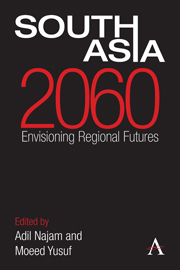Book contents
- Frontmatter
- Contents
- Acknowledgments
- List of Abbreviations
- Introduction: Imagining South Asian Futures
- Section I South Asia as a Region
- Section II State Relations
- Section III Development
- Section IV Human Well-Being
- Chapter 27 Population Dynamics, Economic Prospects and Regional Coherence
- Chapter 28 Towards Cooperation for Poverty Reduction?
- Chapter 29 Health Challenges
- Chapter 30 Regional Disease Dynamics
- Chapter 31 Education: Time Bomb or Silver Bullet?
- Chapter 32 Scholarship in and on South Asia
- Chapter 33 Rights and Justice: A Prospective View
- Chapter 34 Patriarchy, Power and Paradox: Dreaming Gender Equality and Development
- Chapter 35 Women in South Asia
- Chapter 36 Media: New Trends, Old Problems
- Chapter 37 Sports: Passion and Industry
- About the Authors
- Bibliography
- Index
Chapter 36 - Media: New Trends, Old Problems
from Section IV - Human Well-Being
Published online by Cambridge University Press: 05 September 2013
- Frontmatter
- Contents
- Acknowledgments
- List of Abbreviations
- Introduction: Imagining South Asian Futures
- Section I South Asia as a Region
- Section II State Relations
- Section III Development
- Section IV Human Well-Being
- Chapter 27 Population Dynamics, Economic Prospects and Regional Coherence
- Chapter 28 Towards Cooperation for Poverty Reduction?
- Chapter 29 Health Challenges
- Chapter 30 Regional Disease Dynamics
- Chapter 31 Education: Time Bomb or Silver Bullet?
- Chapter 32 Scholarship in and on South Asia
- Chapter 33 Rights and Justice: A Prospective View
- Chapter 34 Patriarchy, Power and Paradox: Dreaming Gender Equality and Development
- Chapter 35 Women in South Asia
- Chapter 36 Media: New Trends, Old Problems
- Chapter 37 Sports: Passion and Industry
- About the Authors
- Bibliography
- Index
Summary
“The open secret of the electronic media, the decisive political factor, which has been waiting, suppressed or crippled for its moment to come, is their mobilizing power,” observed Paul Marris and Sue Thornham in Media Studies: A Reader (2000). That was when the electronic media was the main contender for such moving and shaking. Since then, the Internet, cell phones and social media (like Facebook and Twitter) have made massive inroads into the public domain, impacting public discourse in an unprecedented manner. The merging of these technologies and tools – Internet, cell phones, video, audio, web logs (“blogs”), and social networks – has led to a virtual (no pun intended) revolution that would once have been considered science fiction. So much so that the UN has declared Internet access as an indispensible human right, terming it “an indispensable tool for realizing a range of human rights, combating inequality and accelerating development and human progress.”
The nations that form South Asia, home to about a fifth of the world's population, have much to gain by cooperating to combat common problems like poverty, illiteracy and high fertility rates, unplanned urbanization, gender violence, child labor, poor health services and lack of clean drinking water. The biggest single factor hindering such cooperation is the relationship between nuclear-armed India and Pakistan. Their tensions dominate all regional gatherings, including summits of the South Asian Association for Regional Cooperation (SAARC).
- Type
- Chapter
- Information
- South Asia 2060Envisioning Regional Futures, pp. 284 - 292Publisher: Anthem PressPrint publication year: 2013



